Hungarian Method
The Hungarian method is a computational optimization technique that addresses the assignment problem in polynomial time and foreshadows following primal-dual alternatives. In 1955, Harold Kuhn used the term “Hungarian method” to honour two Hungarian mathematicians, Dénes Kőnig and Jenő Egerváry. Let’s go through the steps of the Hungarian method with the help of a solved example.

Hungarian Method to Solve Assignment Problems
The Hungarian method is a simple way to solve assignment problems. Let us first discuss the assignment problems before moving on to learning the Hungarian method.
What is an Assignment Problem?
A transportation problem is a type of assignment problem. The goal is to allocate an equal amount of resources to the same number of activities. As a result, the overall cost of allocation is minimised or the total profit is maximised.
Because available resources such as workers, machines, and other resources have varying degrees of efficiency for executing different activities, and hence the cost, profit, or loss of conducting such activities varies.
Assume we have ‘n’ jobs to do on ‘m’ machines (i.e., one job to one machine). Our goal is to assign jobs to machines for the least amount of money possible (or maximum profit). Based on the notion that each machine can accomplish each task, but at variable levels of efficiency.
Hungarian Method Steps
Check to see if the number of rows and columns are equal; if they are, the assignment problem is considered to be balanced. Then go to step 1. If it is not balanced, it should be balanced before the algorithm is applied.
Step 1 – In the given cost matrix, subtract the least cost element of each row from all the entries in that row. Make sure that each row has at least one zero.
Step 2 – In the resultant cost matrix produced in step 1, subtract the least cost element in each column from all the components in that column, ensuring that each column contains at least one zero.
Step 3 – Assign zeros
- Analyse the rows one by one until you find a row with precisely one unmarked zero. Encircle this lonely unmarked zero and assign it a task. All other zeros in the column of this circular zero should be crossed out because they will not be used in any future assignments. Continue in this manner until you’ve gone through all of the rows.
- Examine the columns one by one until you find one with precisely one unmarked zero. Encircle this single unmarked zero and cross any other zero in its row to make an assignment to it. Continue until you’ve gone through all of the columns.
Step 4 – Perform the Optimal Test
- The present assignment is optimal if each row and column has exactly one encircled zero.
- The present assignment is not optimal if at least one row or column is missing an assignment (i.e., if at least one row or column is missing one encircled zero). Continue to step 5. Subtract the least cost element from all the entries in each column of the final cost matrix created in step 1 and ensure that each column has at least one zero.
Step 5 – Draw the least number of straight lines to cover all of the zeros as follows:
(a) Highlight the rows that aren’t assigned.
(b) Label the columns with zeros in marked rows (if they haven’t already been marked).
(c) Highlight the rows that have assignments in indicated columns (if they haven’t previously been marked).
(d) Continue with (b) and (c) until no further marking is needed.
(f) Simply draw the lines through all rows and columns that are not marked. If the number of these lines equals the order of the matrix, then the solution is optimal; otherwise, it is not.
Step 6 – Find the lowest cost factor that is not covered by the straight lines. Subtract this least-cost component from all the uncovered elements and add it to all the elements that are at the intersection of these straight lines, but leave the rest of the elements alone.
Step 7 – Continue with steps 1 – 6 until you’ve found the highest suitable assignment.
Hungarian Method Example
Use the Hungarian method to solve the given assignment problem stated in the table. The entries in the matrix represent each man’s processing time in hours.
\(\begin{array}{l}\begin{bmatrix} & I & II & III & IV & V \\1 & 20 & 15 & 18 & 20 & 25 \\2 & 18 & 20 & 12 & 14 & 15 \\3 & 21 & 23 & 25 & 27 & 25 \\4 & 17 & 18 & 21 & 23 & 20 \\5 & 18 & 18 & 16 & 19 & 20 \\\end{bmatrix}\end{array} \)
With 5 jobs and 5 men, the stated problem is balanced.
\(\begin{array}{l}A = \begin{bmatrix}20 & 15 & 18 & 20 & 25 \\18 & 20 & 12 & 14 & 15 \\21 & 23 & 25 & 27 & 25 \\17 & 18 & 21 & 23 & 20 \\18 & 18 & 16 & 19 & 20 \\\end{bmatrix}\end{array} \)
Subtract the lowest cost element in each row from all of the elements in the given cost matrix’s row. Make sure that each row has at least one zero.
\(\begin{array}{l}A = \begin{bmatrix}5 & 0 & 3 & 5 & 10 \\6 & 8 & 0 & 2 & 3 \\0 & 2 & 4 & 6 & 4 \\0 & 1 & 4 & 6 & 3 \\2 & 2 & 0 & 3 & 4 \\\end{bmatrix}\end{array} \)
Subtract the least cost element in each Column from all of the components in the given cost matrix’s Column. Check to see if each column has at least one zero.
\(\begin{array}{l}A = \begin{bmatrix}5 & 0 & 3 & 3 & 7 \\6 & 8 & 0 & 0 & 0 \\0 & 2 & 4 & 4 & 1 \\0 & 1 & 4 & 4 & 0 \\2 & 2 & 0 & 1 & 1 \\\end{bmatrix}\end{array} \)
When the zeros are assigned, we get the following:
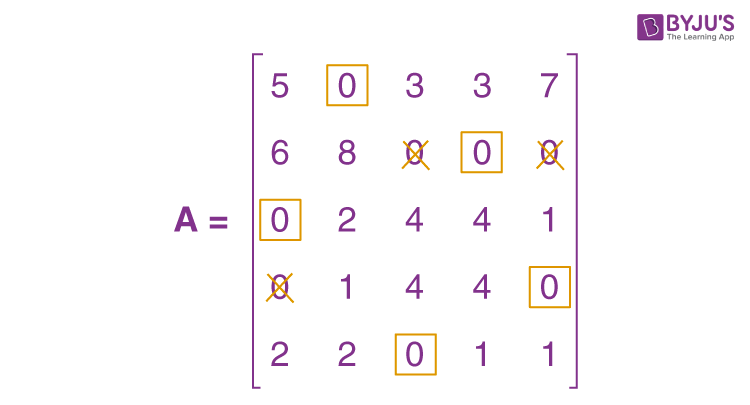
The present assignment is optimal because each row and column contain precisely one encircled zero.
Where 1 to II, 2 to IV, 3 to I, 4 to V, and 5 to III are the best assignments.
Hence, z = 15 + 14 + 21 + 20 + 16 = 86 hours is the optimal time.
Practice Question on Hungarian Method
Use the Hungarian method to solve the following assignment problem shown in table. The matrix entries represent the time it takes for each job to be processed by each machine in hours.
\(\begin{array}{l}\begin{bmatrix}J/M & I & II & III & IV & V \\1 & 9 & 22 & 58 & 11 & 19 \\2 & 43 & 78 & 72 & 50 & 63 \\3 & 41 & 28 & 91 & 37 & 45 \\4 & 74 & 42 & 27 & 49 & 39 \\5 & 36 & 11 & 57 & 22 & 25 \\\end{bmatrix}\end{array} \)
Stay tuned to BYJU’S – The Learning App and download the app to explore all Maths-related topics.
Frequently Asked Questions on Hungarian Method
What is hungarian method.
The Hungarian method is defined as a combinatorial optimization technique that solves the assignment problems in polynomial time and foreshadowed subsequent primal–dual approaches.
What are the steps involved in Hungarian method?
The following is a quick overview of the Hungarian method: Step 1: Subtract the row minima. Step 2: Subtract the column minimums. Step 3: Use a limited number of lines to cover all zeros. Step 4: Add some more zeros to the equation.
What is the purpose of the Hungarian method?
When workers are assigned to certain activities based on cost, the Hungarian method is beneficial for identifying minimum costs.
Leave a Comment Cancel reply
Your Mobile number and Email id will not be published. Required fields are marked *
Request OTP on Voice Call
Post My Comment
- Share Share
Register with BYJU'S & Download Free PDFs
Register with byju's & watch live videos.

Hungarian Algorithm Introduction & Python Implementation
How to use hungarian method to resolve the linear assignment problem..
By Eason on 2021-08-02
In this article, I will introduce how to use Hungarian Method to resolve the linear assignment problem and provide my personal Python code solution.
So… What is the linear assignment problem?
The linear assignment problem represents the need to maximize the available resources (or minimize the expenditure) with limited resources. For instance, below is a 2D matrix, where each row represents a different supplier, and each column represents the cost of employing them to produce a particular product. Each supplier can only specialize in the production of one of these products. In other words, only one element can be selected for each column and row in the matrix, and the sum of the selected elements must be minimized (minimized cost expense).
The cost of producing different goods by different producers:
Indeed, this is a simple example. By trying out the possible combinations, we can see that the smallest sum is 13, so supplier A supplies Bubble Tea , supplier B supplies milk tea, and supplier C supplies Fruit Tea . However, such attempts do not follow a clear rule and become inefficient when applied to large tasks. Therefore, the next section will introduce step by step the Hungarian algorithm, which can be applied to the linear assignment problem.
Hungarian Algorithm & Python Code Step by Step
In this section, we will show how to use the Hungarian algorithm to solve linear assignment problems and find the minimum combinations in the matrix. Of course, the Hungarian algorithm can also be used to find the maximum combination.
Step 0. Prepare Operations
First, an N by N matrix is generated to be used for the Hungarian algorithm (Here, we use a 5 by 5 square matrix as an example).
The above code randomly generates a 5x5 cost matrix of integers between 0 and 10.
If we want to find the maximum sum, we could do the opposite. The matrix to be solved is regarded as the profit matrix, and the maximum value in the matrix is set as the common price of all goods. The cost matrix is obtained by subtracting the profit matrix from the maximum value. Finally, the cost matrix is substituted into the Hungarian algorithm to obtain the minimized combination and then remapped back to the profit matrix to obtain the maximized sum value and composition result.
The above code randomly generates a 5x5 profit matrix of integers between 0 and 10 and generate a corresponding cost matrix
By following the steps above, you can randomly generate either the cost matrix or the profit matrix. Next, we will move into the introduction of the Hungarian algorithm, and for the sake of illustration, the following sections will be illustrated using the cost matrix shown below. We will use the Hungarian algorithm to solve the linear assignment problem of the cost matrix and find the corresponding minimum sum.
Example cost matrix:
Step 1. Every column and every row subtract its internal minimum
First, every column and every row must subtract its internal minimum. After subtracting the minimum, the cost matrix will look like this.
Cost matrix after step 1:
And the current code is like this:
Step 2.1. Min_zero_row Function Implementation
At first, we need to find the row with the fewest zero elements. So, we can convert the previous matrix to the boolean matrix(0 → True, Others → False).
Transform matrix to boolean matrix:
Corresponding Boolean matrix:
Therefore, we can use the “min_zero_row” function to find the corresponding row.
The row which contains the least 0:

Third, mark any 0 elements on the corresponding row and clean up its row and column (converts elements on the Boolean matrix to False). The coordinates of the element are stored in mark_zero.
Hence, the boolean matrix will look like this:
The boolean matrix after the first process. The fourth row has been changed to all False.
The process is repeated several times until the elements in the boolean matrix are all False. The below picture shows the order in which they are marked.
The possible answer composition:

Step 2.2. Mark_matrix Function Implementation
After getting Zero_mat from the step 2–1, we can check it and mark the matrix according to certain rules. The whole rule can be broken down into several steps:
- Mark rows that do not contain marked 0 elements and store row indexes in the non_marked_row
- Search non_marked_row element, and find out if there are any unmarked 0 elements in the corresponding column
- Store the column indexes in the marked_cols
- Compare the column indexes stored in marked_zero and marked_cols
- If a matching column index exists, the corresponding row_index is saved to non_marked_rows
- Next, the row indexes that are not in non_marked_row are stored in marked_rows
Finally, the whole mark_matrx function is finished and then returns marked_zero , marked_rows , marked_cols. At this point, we will be able to decide the result based on the return information.
If we use the example cost matrix, the corresponding marked_zero , marked_rows, and marked_cols are as follows:
- marked_zero : [(3, 2), (0, 4), (1, 1), (2, 0), (4, 3)]
- marked_rows : [0, 1, 2, 3, 4]
- marked_cols : []
Step 3. Identify the Result
At this step, if the sum of the lengths of marked_rows and marked_cols is equal to the length of the cost matrix, it means that the solution of the linear assignment problem has been found successfully, and marked_zero stores the solution coordinates. Fortunately, in the example matrix, we find the answer on the first try. Therefore, we can skip to step 5 and calculate the solution.
However, everything is hardly plain sailing. Most of the time, we will not find the solution on the first try, such as the following matrix:
After Step 1 & 2 , the corresponding matrix, marked_rows, and marked_cols are as follows:

The sum of the lengths of Marked_Rows and Marked_Cols is 4 (less than 5).
Apparently, the sum of the lengths is less than the length of the matrix. At this time, we need to go into Step 4 to adjust the matrix.
Step 4. Adjust Matrix
In Step 4, we're going to put the matrix after Step 1 into the Adjust_Matrix function . Taking the latter matrix in Step 3 as an example, the matrix to be modified in Adjust_Matrix is:
The whole function can be separated into three steps:
- Find the minimum value for an element that is not in marked_rows and not in marked_cols . Hence, we can find the minimum value is 1.

- Subtract the elements which not in marked_rows nor marked_cols from the minimum values obtained in the previous step.

- Add the element in marked_rows , which is also in marked_cols , to the minimum value obtained by Step 4–1.

Return the adjusted matrix and repeat Step 2 and Step 3 until the conditions satisfy the requirement of entering Step 5.
Step 5. Calculate the Answer
Using the element composition stored in marked_zero , the minimum and maximum values of the linear assignment problem can be calculated.

The minimum composition of the assigned matrix and the minimum sum is 18.

The maximum composition of the assigned matrix and the maximum sum is 43.
The code of the Answer_Calculator function is as follows:
The complete code is as follows:
Hungarian algorithm - Wikipedia
Continue Learning
How to convert list to string in python.
In this post, we will go over how to convert a list to a string in Python.
A Beginner’s Guide on Using MQTT— Python IoT
Subscribe and publish message over mqtt using Python
Turning your Python Script into a 'Real' Program
Level up your Python skills by making your programs system services a.k.a well behaved daemon processes— your future self will thank you.
Python FastAPI — Serving Images, MP3 Files, etc. from Your Backend for Beginners
A beginners’ guide on how to serve images, MP3 files, PDF files, DOC files, etc. to frontend from backend using Python FastAPI.
Can You Transcribe Audio Using Python?
6 amazing algorithms to get the square root (and any root) of any number in python.
- Data Structures
- Linked List
- Binary Tree
- Binary Search Tree
- Segment Tree
- Disjoint Set Union
- Fenwick Tree
- Red-Black Tree
- Advanced Data Structures

Hungarian Algorithm for Assignment Problem | Set 2 (Implementation)
- Hungarian Algorithm for Assignment Problem | Set 1 (Introduction)
- Implementation of Exhaustive Search Algorithm for Set Packing
- Greedy Approximate Algorithm for Set Cover Problem
- Introduction to Exact Cover Problem and Algorithm X
- Job Assignment Problem using Branch And Bound
- Prim's Algorithm (Simple Implementation for Adjacency Matrix Representation)
- Introduction to Disjoint Set (Union-Find Algorithm)
- Channel Assignment Problem
- Java Program for Counting sets of 1s and 0s in a binary matrix
- Top 20 Greedy Algorithms Interview Questions
- C++ Program for Counting sets of 1s and 0s in a binary matrix
- C# Program for Dijkstra's shortest path algorithm | Greedy Algo-7
- Java Program for Dijkstra's shortest path algorithm | Greedy Algo-7
- C / C++ Program for Dijkstra's shortest path algorithm | Greedy Algo-7
- Self assignment check in assignment operator
- Python Program for Dijkstra's shortest path algorithm | Greedy Algo-7
- Algorithms | Dynamic Programming | Question 7
- Assignment Operators in C
- Assignment Operators in Programming
Given a 2D array , arr of size N*N where arr[i][j] denotes the cost to complete the j th job by the i th worker. Any worker can be assigned to perform any job. The task is to assign the jobs such that exactly one worker can perform exactly one job in such a way that the total cost of the assignment is minimized.
Input: arr[][] = {{3, 5}, {10, 1}} Output: 4 Explanation: The optimal assignment is to assign job 1 to the 1st worker, job 2 to the 2nd worker. Hence, the optimal cost is 3 + 1 = 4. Input: arr[][] = {{2500, 4000, 3500}, {4000, 6000, 3500}, {2000, 4000, 2500}} Output: 4 Explanation: The optimal assignment is to assign job 2 to the 1st worker, job 3 to the 2nd worker and job 1 to the 3rd worker. Hence, the optimal cost is 4000 + 3500 + 2000 = 9500.
Different approaches to solve this problem are discussed in this article .
Approach: The idea is to use the Hungarian Algorithm to solve this problem. The algorithm is as follows:
- For each row of the matrix, find the smallest element and subtract it from every element in its row.
- Repeat the step 1 for all columns.
- Cover all zeros in the matrix using the minimum number of horizontal and vertical lines.
- Test for Optimality : If the minimum number of covering lines is N , an optimal assignment is possible. Else if lines are lesser than N , an optimal assignment is not found and must proceed to step 5.
- Determine the smallest entry not covered by any line. Subtract this entry from each uncovered row, and then add it to each covered column. Return to step 3.
Consider an example to understand the approach:
Let the 2D array be: 2500 4000 3500 4000 6000 3500 2000 4000 2500 Step 1: Subtract minimum of every row. 2500, 3500 and 2000 are subtracted from rows 1, 2 and 3 respectively. 0 1500 1000 500 2500 0 0 2000 500 Step 2: Subtract minimum of every column. 0, 1500 and 0 are subtracted from columns 1, 2 and 3 respectively. 0 0 1000 500 1000 0 0 500 500 Step 3: Cover all zeroes with minimum number of horizontal and vertical lines. Step 4: Since we need 3 lines to cover all zeroes, the optimal assignment is found. 2500 4000 3500 4000 6000 3500 2000 4000 2500 So the optimal cost is 4000 + 3500 + 2000 = 9500
For implementing the above algorithm, the idea is to use the max_cost_assignment() function defined in the dlib library . This function is an implementation of the Hungarian algorithm (also known as the Kuhn-Munkres algorithm) which runs in O(N 3 ) time. It solves the optimal assignment problem.
Below is the implementation of the above approach:
Time Complexity: O(N 3 ) Auxiliary Space: O(N 2 )
Please Login to comment...
Similar reads.
- Mathematical
Improve your Coding Skills with Practice
What kind of Experience do you want to share?
Procedure, Example Solved Problem | Operations Research - Solution of assignment problems (Hungarian Method) | 12th Business Maths and Statistics : Chapter 10 : Operations Research
Chapter: 12th business maths and statistics : chapter 10 : operations research.
Solution of assignment problems (Hungarian Method)
First check whether the number of rows is equal to the numbers of columns, if it is so, the assignment problem is said to be balanced.
Step :1 Choose the least element in each row and subtract it from all the elements of that row.
Step :2 Choose the least element in each column and subtract it from all the elements of that column. Step 2 has to be performed from the table obtained in step 1.
Step:3 Check whether there is atleast one zero in each row and each column and make an assignment as follows.
Step :4 If each row and each column contains exactly one assignment, then the solution is optimal.
Example 10.7
Solve the following assignment problem. Cell values represent cost of assigning job A, B, C and D to the machines I, II, III and IV.
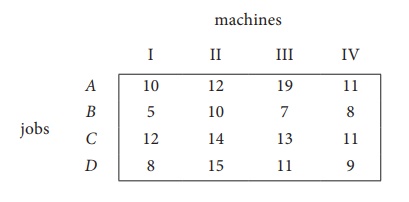
Here the number of rows and columns are equal.
∴ The given assignment problem is balanced. Now let us find the solution.
Step 1: Select a smallest element in each row and subtract this from all the elements in its row.
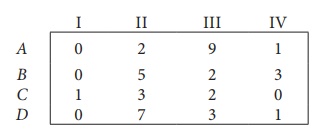
Look for atleast one zero in each row and each column.Otherwise go to step 2.
Step 2: Select the smallest element in each column and subtract this from all the elements in its column.
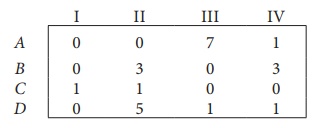
Since each row and column contains atleast one zero, assignments can be made.
Step 3 (Assignment):
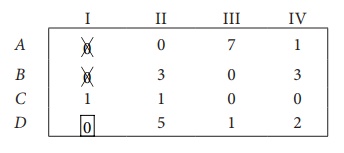
Thus all the four assignments have been made. The optimal assignment schedule and total cost is
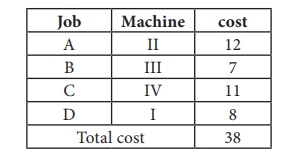
The optimal assignment (minimum) cost
Example 10.8
Consider the problem of assigning five jobs to five persons. The assignment costs are given as follows. Determine the optimum assignment schedule.
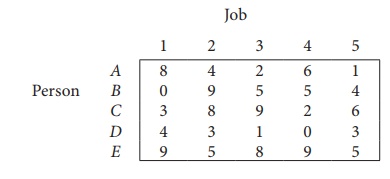
∴ The given assignment problem is balanced.
Now let us find the solution.
The cost matrix of the given assignment problem is
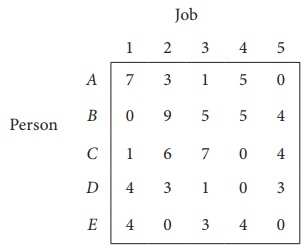
Column 3 contains no zero. Go to Step 2.
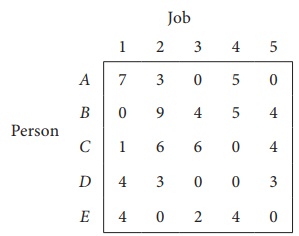
Thus all the five assignments have been made. The Optimal assignment schedule and total cost is
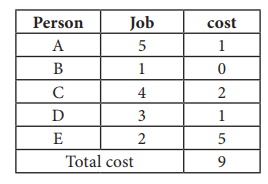
The optimal assignment (minimum) cost = ` 9
Example 10.9
Solve the following assignment problem.
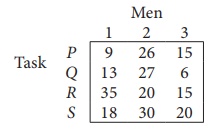
Since the number of columns is less than the number of rows, given assignment problem is unbalanced one. To balance it , introduce a dummy column with all the entries zero. The revised assignment problem is
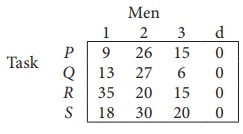
Here only 3 tasks can be assigned to 3 men.
Step 1: is not necessary, since each row contains zero entry. Go to Step 2.
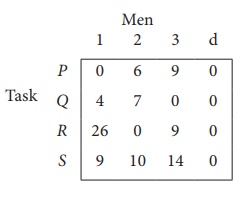
Step 3 (Assignment) :
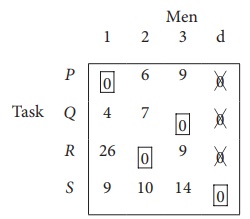
Since each row and each columncontains exactly one assignment,all the three men have been assigned a task. But task S is not assigned to any Man. The optimal assignment schedule and total cost is
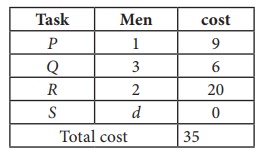
The optimal assignment (minimum) cost = ₹ 35
Related Topics
Privacy Policy , Terms and Conditions , DMCA Policy and Compliant
Copyright © 2018-2024 BrainKart.com; All Rights Reserved. Developed by Therithal info, Chennai.
Hungarian Method Examples
Now we will examine a few highly simplified illustrations of Hungarian Method for solving an assignment problem .
Later in the chapter, you will find more practical versions of assignment models like Crew assignment problem , Travelling salesman problem , etc.
Example-1, Example-2
Example 1: Hungarian Method
The Funny Toys Company has four men available for work on four separate jobs. Only one man can work on any one job. The cost of assigning each man to each job is given in the following table. The objective is to assign men to jobs in such a way that the total cost of assignment is minimum.
This is a minimization example of assignment problem . We will use the Hungarian Algorithm to solve this problem.
Identify the minimum element in each row and subtract it from every element of that row. The result is shown in the following table.
"A man has one hundred dollars and you leave him with two dollars, that's subtraction." -Mae West
On small screens, scroll horizontally to view full calculation
Identify the minimum element in each column and subtract it from every element of that column.
Make the assignments for the reduced matrix obtained from steps 1 and 2 in the following way:
- For every zero that becomes assigned, cross out (X) all other zeros in the same row and the same column.
- If for a row and a column, there are two or more zeros and one cannot be chosen by inspection, choose the cell arbitrarily for assignment.
An optimal assignment is found, if the number of assigned cells equals the number of rows (and columns). In case you have chosen a zero cell arbitrarily, there may be alternate optimal solutions. If no optimal solution is found, go to step 5.
Use Horizontal Scrollbar to View Full Table Calculation
Draw the minimum number of vertical and horizontal lines necessary to cover all the zeros in the reduced matrix obtained from step 3 by adopting the following procedure:
- Mark all the rows that do not have assignments.
- Mark all the columns (not already marked) which have zeros in the marked rows.
- Mark all the rows (not already marked) that have assignments in marked columns.
- Repeat steps 5 (ii) and (iii) until no more rows or columns can be marked.
- Draw straight lines through all unmarked rows and marked columns.
You can also draw the minimum number of lines by inspection.
Select the smallest element (i.e., 1) from all the uncovered elements. Subtract this smallest element from all the uncovered elements and add it to the elements, which lie at the intersection of two lines. Thus, we obtain another reduced matrix for fresh assignment.
Now again make the assignments for the reduced matrix.
Final Table: Hungarian Method
Since the number of assignments is equal to the number of rows (& columns), this is the optimal solution.
The total cost of assignment = A1 + B4 + C2 + D3
Substituting values from original table: 20 + 17 + 17 + 24 = Rs. 78.
Share This Article
Operations Research Simplified Back Next
Goal programming Linear programming Simplex Method Transportation Problem
Quantitative Techniques: Theory and Problems by P. C. Tulsian, Vishal Pandey
Get full access to Quantitative Techniques: Theory and Problems and 60K+ other titles, with a free 10-day trial of O'Reilly.
There are also live events, courses curated by job role, and more.
HUNGARIAN METHOD
Although an assignment problem can be formulated as a linear programming problem, it is solved by a special method known as Hungarian Method because of its special structure. If the time of completion or the costs corresponding to every assignment is written down in a matrix form, it is referred to as a Cost matrix. The Hungarian Method is based on the principle that if a constant is added to every element of a row and/or a column of cost matrix, the optimum solution of the resulting assignment problem is the same as the original problem and vice versa. The original cost matrix can be reduced to another cost matrix by adding constants to the elements of rows and columns where the total cost or the total completion time of an ...
Get Quantitative Techniques: Theory and Problems now with the O’Reilly learning platform.
O’Reilly members experience books, live events, courses curated by job role, and more from O’Reilly and nearly 200 top publishers.
Don’t leave empty-handed
Get Mark Richards’s Software Architecture Patterns ebook to better understand how to design components—and how they should interact.
It’s yours, free.

Check it out now on O’Reilly
Dive in for free with a 10-day trial of the O’Reilly learning platform—then explore all the other resources our members count on to build skills and solve problems every day.

OPERATIONS RESEARCH
Lesson 9. solution of assignment problem.
Current course

Index Assignment problem Hungarian algorithm Solve online
Solve an assignment problem online
Fill in the cost matrix of an assignment problem and click on 'Solve'. The optimal assignment will be determined and a step by step explanation of the hungarian algorithm will be given.
Fill in the cost matrix ( random cost matrix ):
Don't show the steps of the Hungarian algorithm Maximize the total cost
HungarianAlgorithm.com © 2013-2024
Improvement in Hungarian Algorithm for Assignment Problem
- Conference paper
- First Online: 01 January 2014
- Cite this conference paper

- Kartik Shah 5 ,
- Praveenkumar Reddy 5 &
- S. Vairamuthu 5
Part of the book series: Advances in Intelligent Systems and Computing ((AISC,volume 324))
2476 Accesses
5 Citations
Hungarian method for assignment problem is generally used in parallel environment for the assignment of job to a processor. If the number of processors and number of jobs are same, then we can assign each processor 1 job with less cost using Hungarian method. If the number of jobs is larger compared to number of processors, then this method does not work (another approach is using dummy processors, but it is not implementable). In this paper, we proposed an alternate approach same as Hungarian method for assignment of more jobs to lesser processors.
This is a preview of subscription content, log in via an institution to check access.
Access this chapter
- Available as PDF
- Read on any device
- Instant download
- Own it forever
- Available as EPUB and PDF
- Compact, lightweight edition
- Dispatched in 3 to 5 business days
- Free shipping worldwide - see info
Tax calculation will be finalised at checkout
Purchases are for personal use only
Institutional subscriptions
W. Kuhn, The hungarian method for assignment problem. Nav. Res. Logistics Q. 2 , 83–87 (1955)
Article Google Scholar
D.P. Bertsekas, Linear network optimization algorithms and codes (MIT Press, Cambridge, 1991)
MATH Google Scholar
G. Carpaneto, S. Martello, P. Toth, Algorithms and codes for assignment problem. Ann. Oper. Res. 13 , 193–223 (1988)
Article MathSciNet Google Scholar
D.A. Castanon, B. Smith, A. Wilson, Performance of parallel assignment algorithms on different multiprocessor architectures . Alphatech report TP-1245, Burlington, MA, (1989)
Google Scholar
U. Derigs, The shortest augmenting path method for solving assignment problem-motivation and computational experience. Ann. Oper. Res. 4 , 57–102 (1985)
M. Engqust, A successive shortest path algorithm for the assignment problem. INFRO. 20 , 370–384 (1982)
F. Glover, R. Glover, D. Klingman, Threshold assignment algorithm. Centre for Business Decision analysis report CBDA 107, Graduate School of Business, University of Taxes at Austin (1982)
J.R.M. Hall, An algorithm for distinct representatives. Am. Math. Monthly 51 , 716–717 (1956)
R. Jonkar, A. Volgenant, A shortest augmenting path algorithm for the dense and sparse linear assignment problems. Computing 3 , 92–106 (1987)
E. Lawler, Combinational Optimization: Networks and Matroids (Holt, Rinehart & Winston, New York, 1976), p. 206
L.F. Mcginnis, Implementation and testing of a primal dual algorithm for the assignment problem. Oper. Res. Int. J. 31 , 277–291 (1983)
MATH MathSciNet Google Scholar
C.H. Papadimitriou, K. Steiglitz, Combinational Optimization: Algorithm and complexity (Prentice-Hall, Englewood Cliffs, 1982)
E. Balas, D. Miller, J. Pekny, P. Toth, A parallel shortest path algorithm for assignment problem. J. ACM 38 (4), 985–1004 (1991)
Article MATH MathSciNet Google Scholar
Download references
Acknowledgments
The authors would like to thank the School of Computer Science and Engineering, VIT University, for giving them the opportunity to carry out this project and also for providing them with the requisite resources and infrastructure for carrying out the research.
Author information
Authors and affiliations.
School of Computing Science and Engineering, VIT University, Vellore, 632014, India
Kartik Shah, Praveenkumar Reddy & S. Vairamuthu
You can also search for this author in PubMed Google Scholar
Corresponding author
Correspondence to Kartik Shah .
Editor information
Editors and affiliations.
Electrical & Electronics Engineering, Noorul Islam Centre for Higher Education, Kumaracoil, Tamil Nadu, India
L. Padma Suresh
Electrical and Electronics Engineering, SRM Engineering College, Kattankulathur, Tamil Nadu, India
Subhransu Sekhar Dash
Electrical Engineering, IIT Delhi, New Delhi, Delhi, India
Bijaya Ketan Panigrahi
Rights and permissions
Reprints and permissions
Copyright information
© 2015 Springer India
About this paper
Cite this paper.
Shah, K., Reddy, P., Vairamuthu, S. (2015). Improvement in Hungarian Algorithm for Assignment Problem. In: Suresh, L., Dash, S., Panigrahi, B. (eds) Artificial Intelligence and Evolutionary Algorithms in Engineering Systems. Advances in Intelligent Systems and Computing, vol 324. Springer, New Delhi. https://doi.org/10.1007/978-81-322-2126-5_1
Download citation
DOI : https://doi.org/10.1007/978-81-322-2126-5_1
Published : 02 November 2014
Publisher Name : Springer, New Delhi
Print ISBN : 978-81-322-2125-8
Online ISBN : 978-81-322-2126-5
eBook Packages : Engineering Engineering (R0)
Share this paper
Anyone you share the following link with will be able to read this content:
Sorry, a shareable link is not currently available for this article.
Provided by the Springer Nature SharedIt content-sharing initiative
- Publish with us
Policies and ethics
- Find a journal
- Track your research

IMAGES
VIDEO
COMMENTS
Hungarian Method to Solve Assignment Problems. The Hungarian method is a simple way to solve assignment problems. Let us first discuss the assignment problems before moving on to learning the Hungarian method. ... Step 1 - In the given cost matrix, subtract the least cost element of each row from all the entries in that row. Make sure that ...
Time complexity : O(n^3), where n is the number of workers and jobs. This is because the algorithm implements the Hungarian algorithm, which is known to have a time complexity of O(n^3). Space complexity : O(n^2), where n is the number of workers and jobs.This is because the algorithm uses a 2D cost matrix of size n x n to store the costs of assigning each worker to a job, and additional ...
Hungarian Algorithm & Python Code Step by Step. In this section, we will show how to use the Hungarian algorithm to solve linear assignment problems and find the minimum combinations in the matrix. Of course, the Hungarian algorithm can also be used to find the maximum combination. Step 0. Prepare Operations.
Different approaches to solve this problem are discussed in this article. Approach: The idea is to use the Hungarian Algorithm to solve this problem. The algorithm is as follows: For each row of the matrix, find the smallest element and subtract it from every element in its row. Repeat the step 1 for all columns.
Hungarian method for assignment problem Step 1. Subtract the entries of each row by the row minimum. Step 2. Subtract the entries of each column by the column minimum. Step 3. Make an assignment to the zero entries in the resulting matrix. A = M 17 10 15 17 18 M 6 10 20 12 5 M 14 19 12 11 15 M 7 16 21 18 6 M −10
The Hungarian method is a combinatorial optimization algorithm that solves the assignment problem in polynomial time and which anticipated later primal-dual methods.It was developed and published in 1955 by Harold Kuhn, who gave it the name "Hungarian method" because the algorithm was largely based on the earlier works of two Hungarian mathematicians, Dénes Kőnig and Jenő Egerváry.
The Hungarian Method: The following algorithm applies the above theorem to a given n × n cost matrix to find an optimal assignment. Step 1. Subtract the smallest entry in each row from all the entries of its row. Step 2. Subtract the smallest entry in each column from all the entries of its column. Step 3.
The Hungarian Algorithm is used to find the minimum cost in assignment problems that involve assigning people to activities. To use this algorithm, we start by organizing our data into a matrix ...
THE HUNGARIAN METHOD FOR THE ASSIGNMENT. PROBLEM'. H. W. Kuhn. Bryn Y a w College. Assuming that numerical scores are available for the perform- ance of each of n persons on each of n jobs, the "assignment problem" is the quest for an assignment of persons to jobs so that the sum of the. n scores so obtained is as large as possible.
also an optimal assignment for the original cost matrix. Based upon the above discussion, we will consider the classical Hungarian method for problem solving and also we will introduce another approach which will be variant of the original one. It is discussed in the below sections. 2 Existing Work Hungarian method can be used to solve the ...
When using the Hungarian method, you do not build a model, you just pass the cost matrix to a tailored algorithm. You will then use an algorithm developed for that specific problem to solve it. Hence, it will most likely solve it faster since it is a specialist. So if you want to solve an AP you should probably use the tailored algorithm.
The Optimal assignment schedule and total cost is. The optimal assignment (minimum) cost = ` 9. Example 10.9. Solve the following assignment problem. Solution: Since the number of columns is less than the number of rows, given assignment problem is unbalanced one. To balance it , introduce a dummy column with all the entries zero. The revised ...
Hungarian Method is an efficient method for solving assignment problems. This method is based on the following principle: If a constant is added to, or subtracted from, every element of a row and/or a column of the given cost matrix of an assignment problem, the resulting assignment problem has the same optimal solution as the original problem.
Example 1: Hungarian Method. The Funny Toys Company has four men available for work on four separate jobs. Only one man can work on any one job. The cost of assigning each man to each job is given in the following table. The objective is to assign men to jobs in such a way that the total cost of assignment is minimum. Job.
HUNGARIAN METHOD. Although an assignment problem can be formulated as a linear programming problem, it is solved by a special method known as Hungarian Method because of its special structure. If the time of completion or the costs corresponding to every assignment is written down in a matrix form, it is referred to as a Cost matrix. The Hungarian Method is based on the principle that if a ...
Then the problem is to find an assignment so that the total cost for performing all jobs is minimum. Such problems are known as assignment problems. These problems may consist of assigning men to offices, classes to the rooms or problems to the research team etc. Mathematical formulation Cost matrix: c ij= c 11 c 12 c 13 … c 1n c 21 c 22 c 23 ...
9.2.4 Hungarian assignment method. The Hungarian method of assignment provides us with an efficient means of finding the optimal solution. The Hungarian method is based upon the following principles: (i) If a constant is added to every element of a row and/or column of the cost matrix of an assignment problem the resulting assignment problem ...
Solve an assignment problem online. Fill in the cost matrix of an assignment problem and click on 'Solve'. The optimal assignment will be determined and a step by step explanation of the hungarian algorithm will be given. Fill in the cost matrix (random cost matrix):
The Hungarian method, also known as the Kuhn-Munkres algorithm, is a computational technique used to solve the assignment problem in polynomial time.It's a precursor to many primal-dual methods used today. The method was named in honor of Hungarian mathematicians Dénes Kőnig and Jenő Egerváry by Harold Kuhn in 1955.
Keywords: Interval numbers, Assignment problems, Hungarian assignment problem. 1. INTRODUCTION Assignment problem describes that one individual be able to perform one work at a time, to get the optimal solution by maximize the total profit (or) minimize the total cost. Assignment problem can be declared in the form of m x n matrix (c
Hungarian method can be used to solve the assignment problems. General algorithm for assignment problem is as follows: Steps: 1. Obtain the cost matrix from the past history. 2. Find the row minimum of each row and subtract it from the other elements of the corresponding row. 3.
2] for the Hungarian method algorithm of solving the problem. 2.1 Data collection, analysis and conclusion . In this section, we shall consider a computational study and comparison of the new alternate method of assignment by [7] and the Hungarian method for solving University of Port Harcourt tender-job assignment problem.
Unbalanced assignment problem, Hungarian method, Optimal solution. ... modified to solve the assignment problem [3],[4],[5]. Also the signature ... Hence a total opportunity cost matrix is obtained. Step2: Determine whether an optimal assignment can be obtained. (i)Draw the minimum number of horizontal and vertical lines to ...